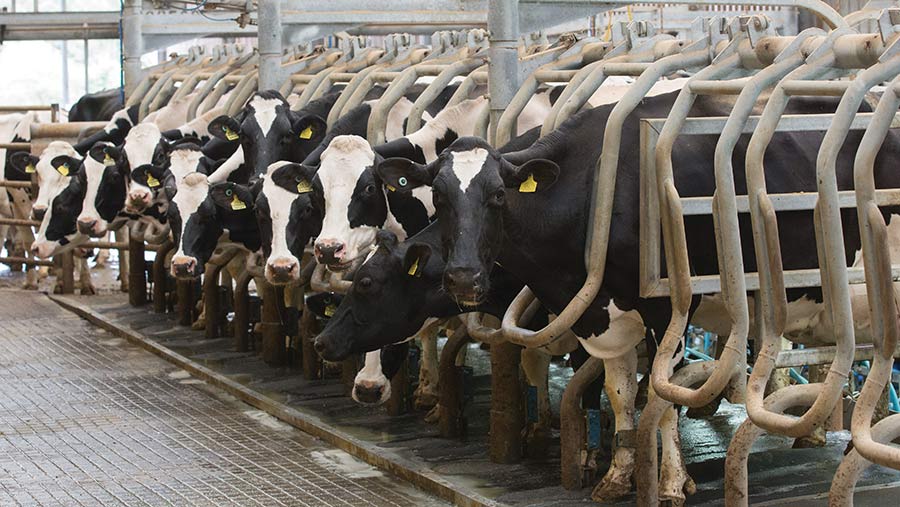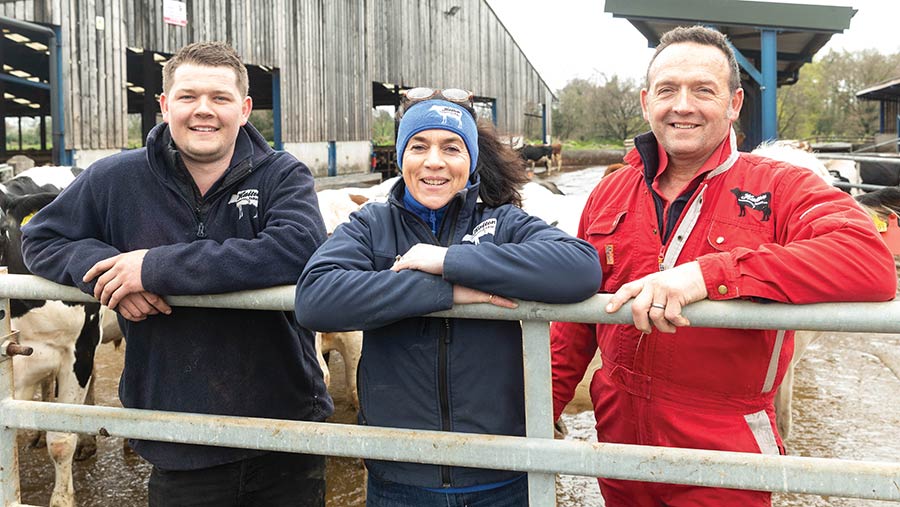Zero-grazing switch cuts dairy feed costs by 2p/litre
 © Tim Scrivener
© Tim Scrivener Transition Farmers Tom and Karen Halton, who milk 530 ProCross cows near Congleton, Cheshire, have always grazed low-yielding cows to improve milk from forage and lower feed costs.
However, they admit it has been a struggle as the extreme seasons have played havoc with grass use.
See also: Transition Farmer update: Labour shortage halts progress in Cheshire
“Because it was so wet, we couldn’t graze early enough this season and then it got away from us, so we had to cut it,” admits Karen.
Farm facts: Halton Farms
- 240ha, tenanted
- Milks 504 ProCross cows (Viking Holstein, VikingRed and Coopex Montbeliarde in a three-way rotation)
- Yields 11,700 litres at 3.8% butterfat and 3.3% protein
- Milks three times a day
- Supplies County Milk
- Selling 1,000 litres/week of raw milk through their farm vending machine for £1.40/litre
Improving milk from forage is one of the Haltons’ business pillars, but they admit it was a weakness.
Determined to fix it, they reseeded the 16ha grazing platform with multispecies leys to improve drought tolerance during the summer and reduce nitrogen use.
This was direct-drilled in April after first cut and slurry was applied immediately afterwards with a dribble bar.
But the idea to zero-graze came about when Karen was loathe to turn the milkers out to graze in the recent hot spell.
“I didn’t want 38-litre cows walking up and down the concrete track in 30C heat, so we decided to consider looking again at zero grazing,” says Karen, who last employed this practice six years ago.
“We had an old zero-grazer that put grass in a feed trailer, but not enough cows could feed around it and grass got hot,” explains Tom.

Jack, Karen and Tom Halton © Tim Scrivener
How it works
Having a forage box on demonstration convinced them the saving was worthwhile, so they invested in a second-hand Veenhuis forage wagon that cost £16,000.
A front-mounted McHale mower is used to cut the grass. This doubles up for silage-making alongside a set of butterfly mowers.
The grazing platform is mown at 1pm to provide the cows with fresh grass for their 2pm feed.
About 1ha is harvested, which is also enough for the morning feedout at 6am.
Grass is spread out in a thin layer in the silage clamp to prevent it from heating.
For the past three seasons, the couple have applied SmartGrass growth enhancer, but this year they could only get enough to do half.
Therefore, first cut was taken off the grazing platform in two stages at the end of April and the beginning of May, which helped create a wedge so the grass was not ready for zero grazing all at once.
They have already completed one round and are just about to enter their third. Karen still measures the grazing platform once a week using a plate meter and records the results on the management app, AgriNet.
The aim is to cut the grass before it surpasses 4,000kg/ha of dry matter (DM).
The fresh grass is mixed into the cow’s total mixed ration (TMR) using their BvL self-propelled mixer wagon.
Cows are fed out of troughs which have been lined with parlour cladding to make it easier for them to be cleaned out each day, explains Tom.
Saving
Daily milk yields of 37.2kg have been maintained alongside constituents of 3.8% butterfat and 3.3% protein.
Purchased feed costs have been lowered from £860/day to £585/day, taking them from 11.9p/litre to 9.9p/litre.
This has been achieved through lowering the amount of concentrate feed rate to 0.29kg/litre by reducing blend and brewers’ grains and parlour nuts, says the Halstons’ cattle specialist, Stephanie Hurstfield from Feeding Solutions.
“We have achieved this by replacing 24% of the original TMR with fresh grass, with the view to increase this to nearer 29%.”
Tom explains: “There is a cost to zero grazing, but there’s a bigger cost to making silage and we are not using as much maize in the ration. We don’t have to ted or buck rake and neither do we have the expense of clamping the silage.”
Protein and energy losses from field to clamp can amount to as much as 15-20%, which means fresh grass is also much higher in nutritional value.
Grass use is better too.
The couple have also lowered the amount of fertiliser applied to the grass platform in-between cuts from 148 to 111 units/ha since establishing the herbal leys.
Alongside this, 37 units/ha of slurry is applied with a 3,000g slurry tanker and dribble bar the day after grass is cut.
Benefits of the system
Karen says with the summers getting hotter, zero grazing is a good way to drive forage intakes without compromising cow welfare.
“I do not want the cows standing out in the field during the heat. We put fans in the low-yielding cow shed three years ago and the shed is nice and cool, and cows are not expending energy walking to paddocks when it is hot outside.”
Tom says zero grazing also fits better with their high-input system.“You must do what you are interested in and what you can make work.
“For us, zero grazing is the next best thing and I feel we can manage it well. It does take a while for you to get used to the management and you must do it for three to four weeks before you get consistency,” he concedes.
Another benefit of zero grazing is that they can access land they couldn’t graze with the cows.
A mob of 60 in-calf heifers also runs on the platform to help manage growth.
“We manage it so the heifers are given priority to graze on the platform and, if needed, we can zero-graze the silage platform because we won’t need to make as much [silage] now,” says Karen.
Improving home-grown forage
Every acre is cropped year round to maximise home-grown forage.
“When you improve milk from forage you need more forage, so we will have to stitch in more vigorous leys,” says Tom, who is already direct-drilling grass after maize and has moved away from ploughing maize ground.
These practices helped lift yields to 59t/ha on average last year, he believes.
About 12ha of hybrid rye has been grown for the second consecutive year for dry cow forage.
“It is low in phosphate, which means we don’t have to chop as much straw, and it is very high yielding. Last season we grew 62t/ha,” says Tom.
Fast-growing Westerwold ryegrass will be sown after the hybrid rye, which will provide two cuts of grass – one in the autumn and one in the spring – before the fields are planted with maize.
Total mixed ration (freshweight)
- 20kg fresh grass
- 13.5kg first-cut silage
- 1.2kg straw
- 4.1kg brewers’ grains
- 3.4kg home-made blend
- 11.5kg maize
Staff management
People are another key business pillar for the Haltons, alongside cow health and welfare.
Karen used to work in recruitment and places a big focus on attracting new entrants.
Nine of the farm’s 10 employees do not have a farming background.
The couple put this success down to the effort they put into opening their farm gate online and in person.
As well as having a presence on social media platforms, they recently attracted 800 people to an Open Farm Sunday event.
“A big driver for us is demonstrating agriculture in a positive way and showcasing the high levels of welfare we operate, as well as the career opportunities agriculture offers,” says Karen.
While they are not immune to staff challenges, Karen says creating a good environment for the team to thrive is important.
“We haven’t had a herdsperson for over a year, but everybody steps up. Having protocols in place is a massive part of it, as is respecting and valuing the staff you have.” She says one of the best bits of advice she can give is not to put up with poor performers.
“If you put up with bad apples, staff get disheartened. When you remove bad apples, productivity goes up, so I’m not afraid of removing people when they are not the right fit for my business.”
Karen and Tom Halton are one of our Transition Farmers. Join them as Halton Farm strives to become financially and environmentally sustainable and overcome the challenges it faces over the next five years.
